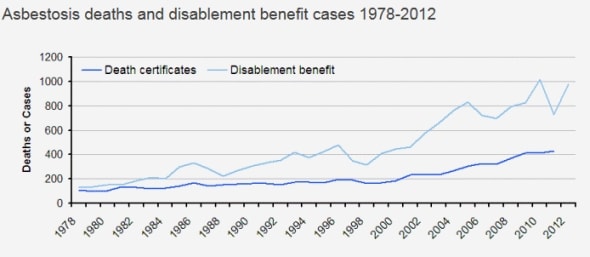History of Asbestosis Cases in the UK
By Kathy Cooke. 17th January 2014
Cases of asbestosis in the United Kingdom continue to increase reflecting high asbestos exposure in years gone by.
Asbestosis is fibrosis of the lung tissue caused by breathing in asbestos fibres. Large quantities of asbestos fibres are usually required to produce this very damaging disease for which there is no cure.
The disease does not manifest itself for several decades after exposure and so the current increase in the number of asbestosis cases and deaths reported to HSE reflects high levels of asbestos inhalation in years gone by.
Current Asbestosis Statistics
The number of deaths where asbestosis was considered to have contributed as a cause of death was 429 in 2011. This is nearly four times the level in 1978 where 109 deaths were attributed to asbestosis.

Diagram Ref: https://www.hse.gov.uk/statistics/causdis/asbestos-related-disease.pdf
These figures do not include those deaths where death certificates mention both asbestosis and mesothelioma – sometimes asbestosis is mentioned incorrectly by coroners as meaning asbestos related disease.
The asbestosis register for 2011 contains 178 deaths where asbestosis was recorded as the actual underlying cause of death (HSE statistics 2012).
It is interesting that the number of newly assessed cases for Industrial Injuries Disablement Benefit have increased more rapidly than actual asbestosis deaths in recent years with the number of cases for 2012 being 980.
These statistics would indicate that the number of deaths from asbestosis will continue to increase in the next few years.
When was the first recorded case of Asbestosis?
It is 90 years since the first recorded case of asbestosis was described in medical literature. Nellie Kershaw, a textile worker from Rochdale, died at the very young age of 33 yrs in 1924 from asbestosis. Sadly she received no income or benefits of any kind from mid 1922 until her death and was buried in an unmarked pauper's grave.
Nellie worked for Turners Brothers Asbestos in the north of England manufacturing cotton cloth based packaging. Turners was quite revolutionary at the time in that it was the first business in the UK to weave asbestos cloth with power-driven machinery. Obviously this was before the devastating effects of asbestos were known.
Nellie showed symptoms of what we now know as asbestosis in 1920 when finally in 1922 they became too much and she as certified unfit to work due to the diagnosis of ‘asbestos poisoning’. At that time this particular diagnosis made her ineligible for NHS sickness benefits as the illness was linked to her work. She was advised to seek monies from her employers under the Workmen's Compensation Act, but as asbestosis was not a recognised occupational disease in the 1920s, Turner Brothers refused to pay as they refuted the statement that asbestos was poisonous. They refused compensation to Nellie’s family following her death and would not contribute to the cost of the funeral.
Nellie's death certificate documented ‘fibrosis of the lungs due to the inhalation of mineral particles” as the cause of death and in the article about her case later published in the BMJ the term ‘pulmonary asbestosis’ was adopted.
Thankfully later enquiries into Nellie’s death led to the publication of the first Asbestos Industry Regulations in 1931 which came into effect in 1932.

Author
Kathy Cooke MA. BSc
Cancer consultant and advisor
Kathy has worked in the cancer field for over 30 years. She was course leader for the MSc in Radiotherapy and Oncology at University of Hertfordshire. Then pre-treatment radiotherapy manager at the Cromwell Hospital in London and Partnership Quality Lead for Macmillan Cancer Support.. Read more >













